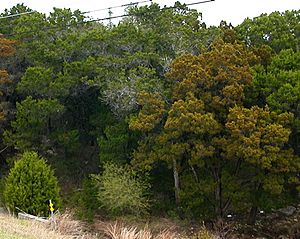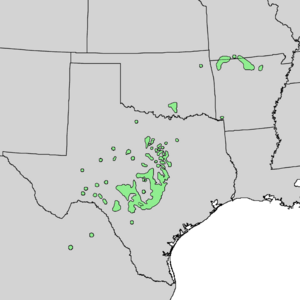Ashe juniper facts for kids
Quick facts for kids Ashe juniper |
|
|---|---|
 |
|
| J. ashei shedding pollen: mature male on right, immature tree on left, mature green females in background | |
| Conservation status | |
| Scientific classification | |
| Genus: |
Juniperus
|
| Species: |
ashei
|
 |
|
| Natural range of Juniperus ashei | |
| Synonyms | |
|
J. sabinoides (H.B.K.) Nees sensu Sargent |
|
The Ashe juniper (scientific name: Juniperus ashei) is a special kind of evergreen tree. It's also known by names like Mountain Cedar or Blueberry Juniper. This tree is very good at handling dry weather.
You can find Ashe junipers growing naturally in northeastern Mexico and the south-central United States. They are common from Texas all the way up to southern Missouri. Huge groups of these trees grow in central Texas.
Ashe junipers can grow quite tall, usually up to 10 meters (about 33 feet). Some can even reach 15 meters (about 49 feet) over time! These trees are helpful because they stop soil from washing away (this is called erosion control). They also give shade all year round for wild animals and farm animals.
The leaves of the Ashe juniper look like small scales. They are about 2 to 5 millimeters (0.08 to 0.2 inches) long. These leaves grow in thick, bright green bunches on round branches.
Ashe junipers are "dioecious" plants. This means that each tree is either a male plant or a female plant. They have separate male and female trees.
The female trees produce small, round cones. These cones are soft and look like berries. They are about 3 to 5 millimeters (0.12 to 0.2 inches) long. At first, they are green, but they turn purple when they are ready. This happens about 8 months after the tree is pollinated. Inside these "berry-like" cones are one or two seeds. Birds love to eat these cones. When birds eat them, they help spread the seeds in their droppings.
The male trees have smaller cones, about 3 to 5 millimeters long. These cones are yellow. They turn brown after they release their pollen. This usually happens from December to February.
Contents
What's in a Name?
The scientific name ashei was chosen to honor an American expert on trees and plants. His name was William Willard Ashe.
Allergic Reactions
The pollen from Ashe juniper trees can cause a strong allergic reaction in some people. This allergy is often called "cedar fever" in Texas. It's similar to hay fever, but it happens in winter. Another related tree, Juniperus virginiana, also releases pollen. So, if you have a winter allergy from Ashe juniper, it might continue into spring when J. virginiana starts releasing its pollen.
How People Use Ashe Juniper
Ashe juniper wood is very strong and doesn't rot easily. This makes it great for building things that need to last a long time.
Building Materials
- Fence Posts: People often use the wood for fence posts. Posts made from old Ashe juniper trees can stay strong in the ground for more than 50 years!
- Other Uses: Over 100 years ago, many old Ashe juniper trees were cut down. Their wood was used for fence posts, but also for building foundations, telephone poles, roof frames, and even railroad ties.
Helping Wildlife
- Food for Animals: The berry-like cones are a food source for many wild animals.
- Homes for Birds: The endangered golden-cheeked warbler is a small bird that uses the peeling bark from older Ashe juniper trees to build its nests. These birds also live in areas with old Ashe juniper trees mixed with oak trees.
Ashe Juniper in Texas
When Spanish explorers came to what is now Texas in the mid-1700s, they used Ashe juniper trees to build the roofs of their missions in the Hill Country.
For many years, people didn't manage the land well. They cut down too many trees and let too many animals graze. This caused the soil to wash away, leaving behind a rocky type of soil called caliche. The Ashe juniper was one of the few plants that could grow well in this rocky ground.
Even though Ashe juniper is native to Texas, some landowners and ranchers see it as a problem plant or a "weed." They used to think that Ashe junipers used more water than live oaks. However, newer studies suggest that this might not be true.
Ashe junipers grow well on ranches because cattle don't like to eat their bitter-ttasting young plants. Unlike another type of juniper called redberry juniper, Ashe juniper trees do not grow back from their stump after they are cut down.


